Baghramian has explored the relation of modeling, molding, and casting—interrelated elements of sculpture production involving positive and negative forms—throughout her career, and she consistently humanizes this largely mechanical process through overt or oblique references to the body. Using an abstract vocabulary that often combines geometric and organic forms, as well as industrial materials and processes with elements that appear soft and supple, Baghramian highlights the subtle ligatures uniting disparate human activities. In Formage de tête, presented in 2011 at the 54th Venice Biennial, she drew parallels between artistic, culinary, and bodily processes by draping tables with silicone sheets showing the voids of various shapes: such concavities, made by casting objects into the silicone sheet and removing them, could theoretically be used to cast those objects anew. The title literally translates to “forming of the head,” something a traditional sculptor might do, but it is also a pun on “fromage de tête,” or “head cheese,” a jelly made from the flesh of a calf’s or pig’s head by being set (or cast) in aspic, lending the silicone sheets an unexpected association. Typical of Baghramian, this touch of punning humor disarms even as it draws attention to the potentially unsettling connections between sculpture, cooking, and consumption.
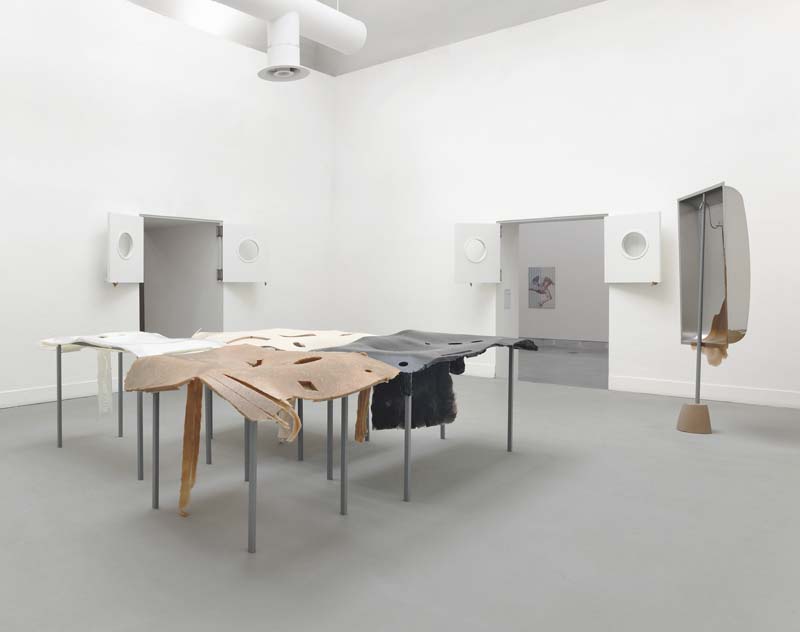 Formage de tête, 2011
Formage de tête, 2011
Silicon, steel, lacquer, aluminum, silicon, stainless steel, lacquer, cast iron.
Installation view, Venice Biennale, 2011, Italy
Similarly, in the 2012 installation Retainer Baghramian erects a semi-circular phalanx of barriers in the gallery, partially surrounding the viewer—impeding movement through the space even as it offers a kind of embrace. As suggested by its title, Retainer’s amoeboid shields of cast silicone and polycarbonate, mounted on thin, polished aluminum supports recall the transparent plastic and wires of orthodontic apparatuses. Baghramian elaborates these motifs in the series Scruff of the Neck from 2016, with more overt evocations of dental forms. Likewise, her recent work, Knee and Elbow, commissioned for the Clark Art Institute in Williamstown, MA, in 2020, suggests a monument to parts of the body that bend and often fail: arches formed of large sections of pink and white marble connected with polished stainless-steel fittings like enormous bones sutured back together with medical-grade steel pins.
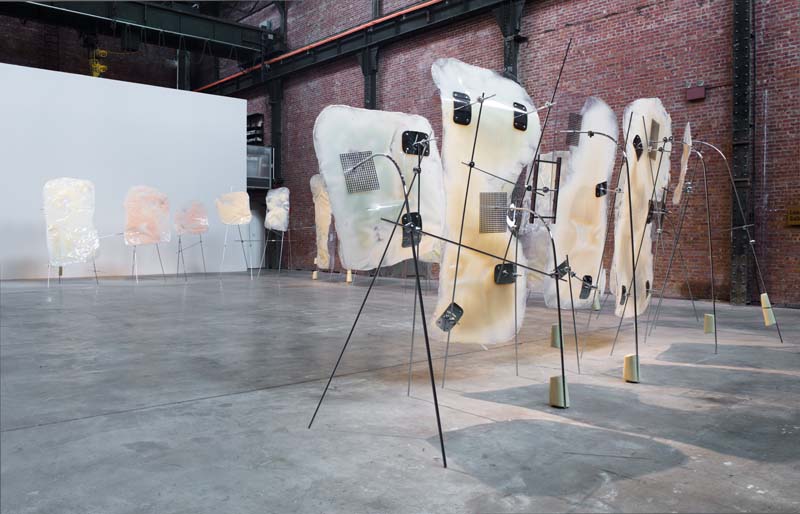 Retainer, 2012
Retainer, 2012
Cast and painted aluminum, silicon, polycarbonate, chromed metal
Installation view, Sculpture Center, New York, 2012
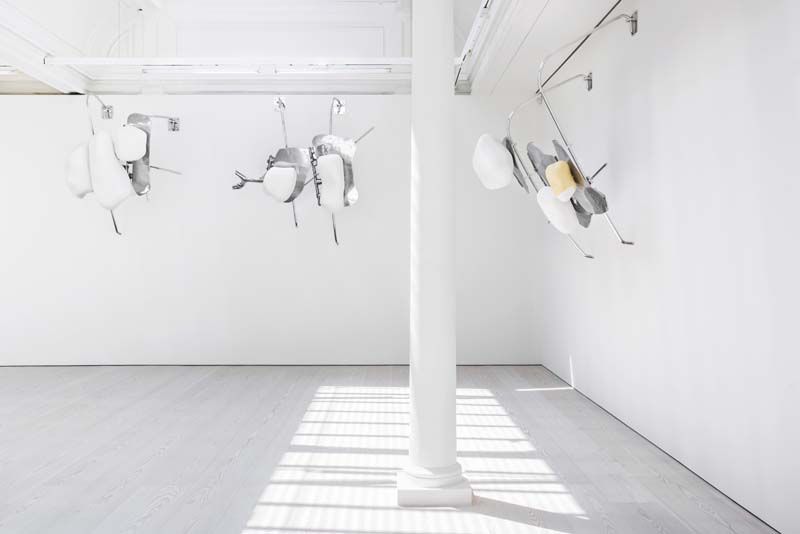 Scruff of the Neck, 2016
Scruff of the Neck, 2016
Cast and polished aluminum, polished aluminum rods, plaster, beeswax, rubber
Installation view of Scruff of the Neck at Marian Goodman Gallery, London 2016
Photo: Thierry Bal
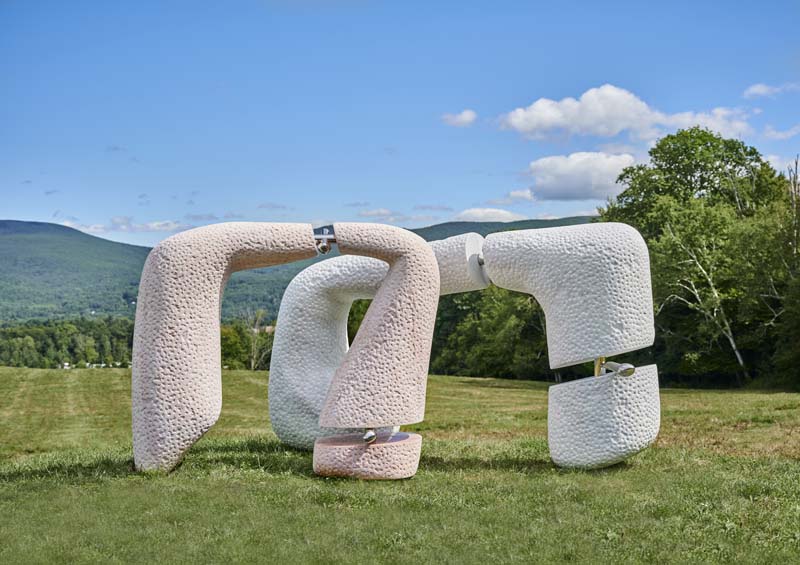
Knee and Elbow, 2020
Marble, cast stainless steel, Elbow: 61 ¹³⁄32 x 75 ¹?⁄32 x 27 ?⁄16 in. (156 x 192 x 70 cm); Knee: 61 ¹³⁄32 x 107 ¹5⁄32 x 27 ¹5⁄16 in. (156 x 273 x 71 cm)
Photo: Thomas Clark
Baghramian’s sculptures often rely on external supports, architecture, or each other for their stability; in doing so, they often suggest parallels with the body’s own interior architecture, such as the mouth and the skull. The Dwindlers comprise curved sections of cast glass held in place by rough, zincked-metal supports bolted to the gallery wall, encapsulating space in segmented runs through a room, even across doorways. The works suggest not only deteriorating ducts or chutes, but also intestinal passages or prostheses, lending the industrial associations a vulnerability not normally ascribed to them. This sense of support and care extends to the Maintainers, a series of multipart sculptures that lean on one another and incorporate external braces and clamps for stabilization. The materials Baghramian uses are related to one another through studio processes in which one type of substance is used to protect another: the wax of one large form, for example, could be applied to the raw cast aluminum object next to it. The work thus contains within it an existential dilemma: the destruction of one element (wax) to assure the continued health of the other (aluminum).
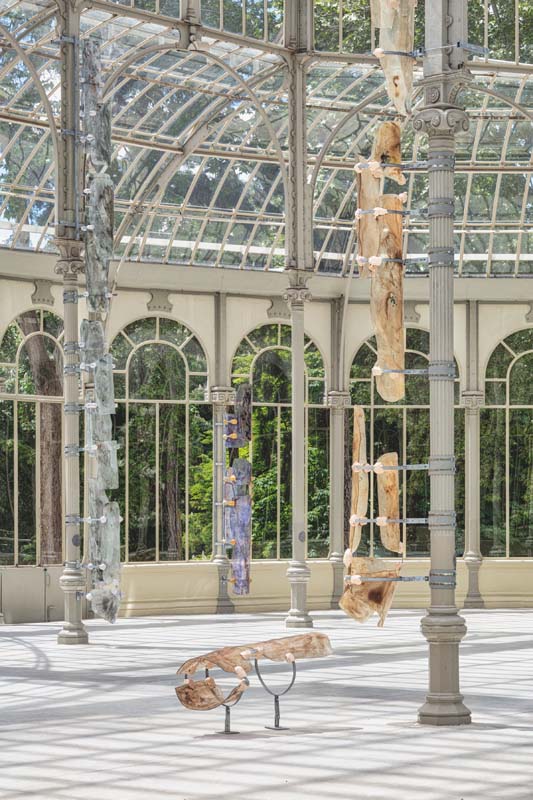 Dwindlers, 2018
Dwindlers, 2018
Glass, zinc-coated metal, colored epoxy resin
Installation view of Breathing Spell at Crystal Palace, Museo Nacional Centro de Arte Reina Sofia, Madrid, 2018
Photo: Timo Ohler
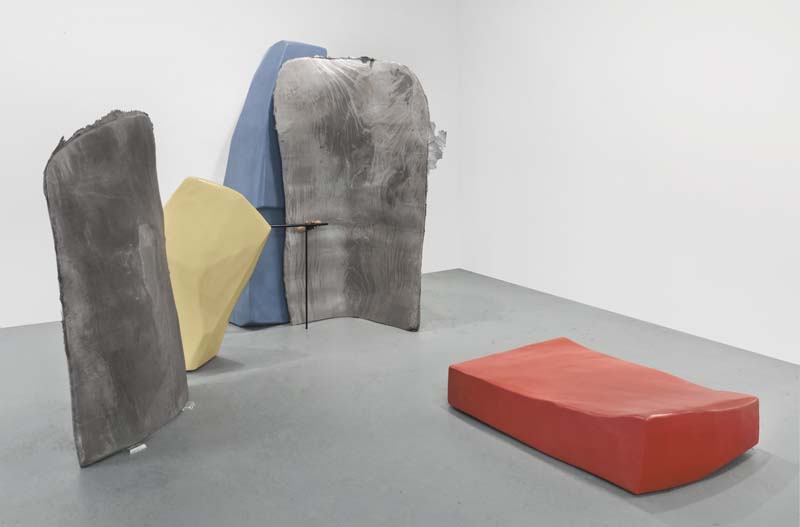 Maintainers (H), 2019
Maintainers (H), 2019
Cast aluminum, painted aluminum, cork, styrofoam, pigmented paraffin wax
92 ¹7⁄32 x 161 ¹³⁄32 x 110 ¹⁄4 in. (235 x 410 x 280 cm)
Photo: Cathy Carver
While much of Baghramian’s work involves a critical engagement with architecture and obdurately obstructing passages, certain sculptures register more subtly, although they antagonize and complicate prescribed art spaces and viewers’ expectations in equal measure. Such works fail to quite arrive at appearing as sculpture, instead teetering between identities and delivering a confounding set of visual cues. Peeper (2016), for example, comprises thick metal wire outfitted along its length with blue rubber washers and secured to an orange clamp anchored to the wall. When installed at the Walker Art Center in Minneapolis in 2017, Baghramian left one end of the long metal cord on the ground, flaccid and untethered from a second anchor on the adjacent wall, on the other side of a doorway, to which it should presumably have been fastened. This gave the impression that a barricade had been breached and the gallery unlawfully entered, creating an unsettling ambiguity for the viewer about Peeper's status as art and rendering the entrance into the gallery an experience of possible trespass, much as the sculpture’s title suggests.
Other works, most notably the series called Stay Downers, references a different realm of ineptitude, illicitness, or abjection. Though appearing formally resolved, these polyurethane and silicone forms’ German title Sitzengebliebene designates students who have been left back a grade in school. Individual works specify the exact nature of the problem, identifying with reductive labels those lowest on the adolescent social ladder: Nerd, Ugly Duckling, Malingerer, Babbler, Truant. The clusters of sculptures—thick, interlocking blobs or narrow, irregular oblongs in pastels and fleshy tones—are often installed in hard-to-reach corners or shyly along the wall, a cohort of the rejected. The somewhat organic forms of the Stay Downers further play with notions of social rejection by recalling cast-off or expelled products of the body, implicitly suggesting a connection to the efforts of artists.
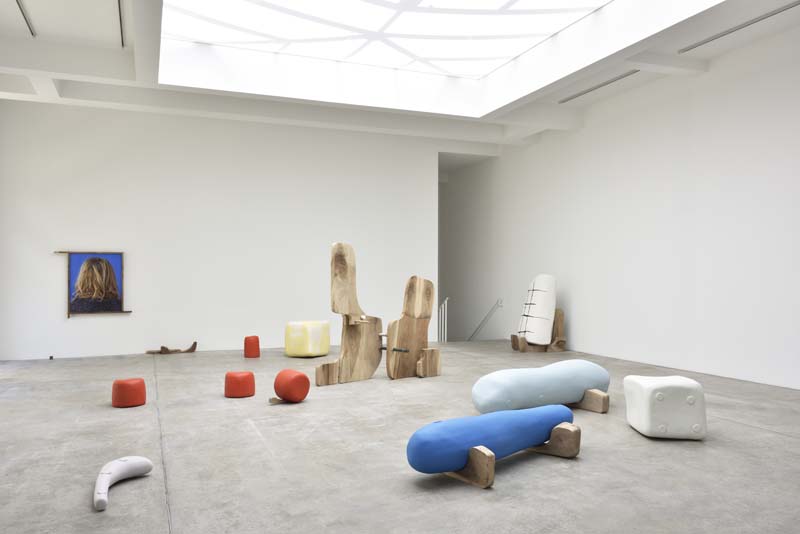 Misfits, 2021
Misfits, 2021
Varnished cast aluminum, walnut wood from Danh Vo's McNamara project, marble, C-print in artist frame
Installation view of Misfits at Marian Goodman Gallery Paris, 2021
Photo: Rebecca Fanuele
Her recent series Misfits, which was highlighted this past summer in exhibitions at Galleria d’Arte Moderna in Milan and the Paris branch of Marion Goodman Gallery, looks to children as another category of social outlier in a series of sculptures and photographs that consider the playground as a political space. Resembling interlocking children’s toys, the brightly colored sculptures suggest the capacity of toys to fit together—except closer inspection reveals that any sense of possible completion or tidiness in the objects is thwarted, and the playfulness the works seem to promise is unfulfilled. Further heightening the sense of refusal, in Milan Baghramian placed several sculptures outside on the terrace of the building with the mandate that only children and their caregivers were allowed to visit and interact with the works there, inverting the ubiquitous prejudice within art spaces against the young, and by extension, their parents. This reversal of the access paradigm makes the artist’s deep commitment to those without recognized social stature physically manifest.
In tandem with this transgressional affection for the overlooked are Baghramian’s collaborations with other women artists. Her longest-running collaboration is with the late Swiss-French designer and artist, Janette Laverrière (1909–2011), with whom Baghramian became acquainted in 2008. The two began working together for the 2008 Berlin Biennale 5, for which the duo created La Lampe d’Horloge (2008)—an architectural plexiglas enclosure based on Laverrière’s Paris apartment that comprises several of the designer’s mirror sculptures and interior objects recontextualized in a form and frame designed by Baghramian. For the artist, it was important that their collaboration did not involve her appropriation of aspects of Laverriere’s practice; rather, as she described her approach in an interview with Jörg Heiser, “I’m interested in the political implications of interior design; namely, why certain designers – mainly women and gay men – withdrew so markedly from the public realm of architecture or urban planning to concentrate on the domestic sphere. It is here that they engaged with objects.”
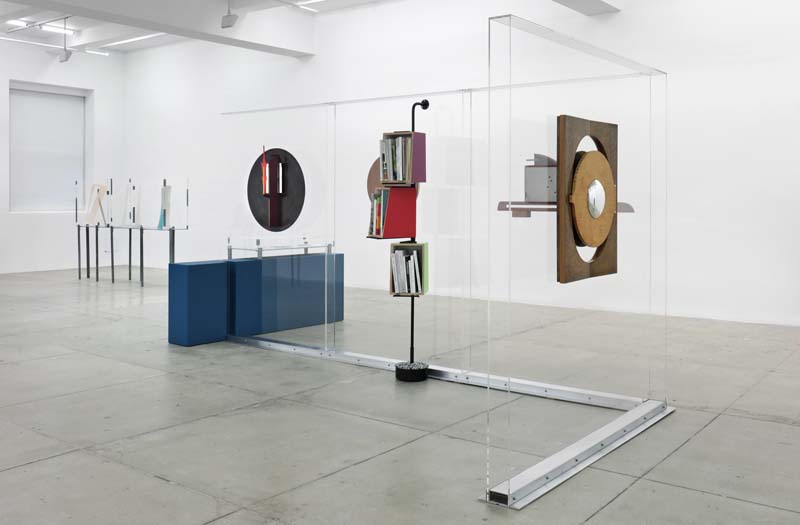 Installation view Work desk for an Ambassador's Wife, Marian Goodman Gallery NY, 2019
Installation view Work desk for an Ambassador's Wife, Marian Goodman Gallery NY, 2019
Baghramian has developed this interest in the binaries of interior/exterior, private/public, process/production, feminine/masculine throughout her work, notably in her most recent collaboration with the late designer, the 2019 exhibition Work Desk for an Ambassador’s Wife at Marian Goodman Gallery, New York. Inspired by Laverriére’s renunciation of useful objects in her own designs, Baghramian included maquettes, drawings, and sketches from her own series Side Leaps of works never intended to be realized. Having no function or purpose, these are works which, in Baghramian’s words “have not been allowed to become sculpture.” Showing these unrealized works from 1999 to 2019 was a way for the artist to examine the relationships between beauty and the feminine, productivity, and use values, and the dysfunctional. Encased in Plexiglas vitrines, Baghramian’s unrealized projects masquerade as finished works, as if hoping to pass as functional sculptures. Among Baghramian’s Side Leaps, the artist installed La Lampe d’Horloge, her first collaboration with Laverrière, complicating what passes for finished or functional. Through her collaborations with Laverrière, Baghramian has hoped to provide a more public platform for the designer’s ideas and interior objects, and to take Laverrière from the interior, domestic, or private spaces more frequently inhabited by women to the public spaces dominated by men.
When the Nasher Prize jury deliberated in June 2021 to determine the 2022 laureate, the world was under the grip of a global pandemic—a grip that is still very firm—that required people everywhere to stay home, isolated from friends and family, and without the opportunity to engage with vital social spaces—restaurants, libraries, museums—that nurture the human body, relationships, and the imagination. Bearing in mind the deep longing for the physical presence of loved ones, places and things, the work of Nairy Baghramian stood out to the jury as exemplary for its tender and ebullient considerations of the material virtue of our bodies, our built environments, and of the great, good, and lasting service that sculpture in the most traditional sense—that is, physical objects—can offer the human spirit.